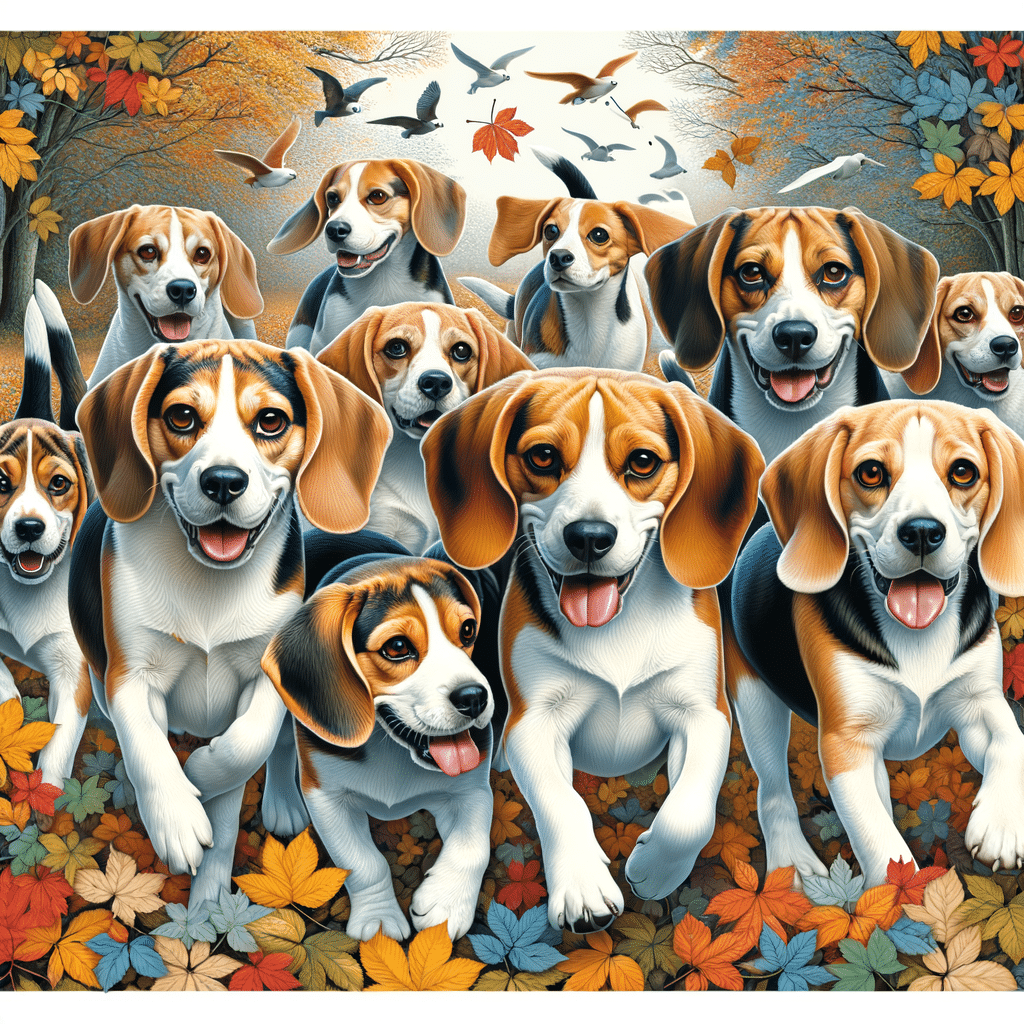When considering the addition of a furry friend to your family, the choice between a beagle and a pit bull terrier often arises. With beagle vs. pit, understanding each breed and its characteristics is vital.
In This Article
The beagle’s friendly demeanor, compact size, and keen sense of smell endear it as a companion and a skilled hunter. On the other hand, the American pit bull terrier showcases a strong, loyal, and affectionate nature, though it has been historically misunderstood.
While both are excellent with children, these breeds pose different considerations regarding training, socialization, and care for you as a dog owner.
Each breed presents unique care requirements and health considerations. Beagles are generally low-maintenance but need ample exercise to manage their energy levels. At the same time, pit bulls require physical activity and rigorous training to ensure their powerful bodies and minds stay engaged.
In terms of health, you need to engage in preventative care for each breed. Finally, both breeds’ living environment and social needs can vastly differ; beagles often thrive with space to explore, whereas pit bulls can adapt well to various settings if provided with love and stability.
Highlights
- Beagles and pit bulls are suitable for families, offering distinct traits that cater to different lifestyles.
- Proper care, including regular exercise and preventative health measures, is vital for both breeds.
- Appropriate socialization and training are essential to ensure a well-adjusted and happy dog, regardless of the breed.
Breed Origins and History
Exploring the roots of breeds adds depth to our understanding of their characteristics and behaviors. The beagle and the pit bull carry rich histories, marked by their roles in hunting and companionship and their journeys to becoming beloved purebreds.
Beagle History
The beagle’s origins can be pinpointed to ancient Greece. Early records suggest the existence of small hound-like dogs used for hunting, subsequently making their way to England. Through selective breeding practices, these dogs evolved into the modern beagle. The breed’s name is believed to stem from the French term beguile, which means “open throat,” reflective of the beagle’s vocal nature.
- Use in hunting: Initially bred for hunting small game due to their keen sense of smell and stamina.
- Purebred development: Beagles have been refined into the breed recognized today for centuries.
Pit Bull History
The pit bull’s history is closely associated with the American pit bull terrier (APBT), a breed recognized by the United Kennel Club (UKC). Its origins can be traced to early fighting dogs from England and Ireland, imported to the United States and used in blood sports like bullbaiting. After these practices were outlawed, the pit bull found a new role as a working dog and companion.
- Historical Roles: Initially used in blood sports, transitioned to roles in farming, hunting, and as family pets.
- Recognition by UKC: The breed gained official recognition in the late 19th century, reflecting its distinct characteristics and popularity in America.
The beagle and the pit bull have long-standing histories. The former is a specialized hunter, and the latter emerged from a controversial past to become beloved as a versatile and dedicated companion.
Physical Characteristics and Temperament
When comparing the beagle and pit bull breeds, distinct physical characteristics and temperament differences are notable. These characteristics define their suitability to various families and lifestyles.
Beagle Traits
Beagles are small- to medium-sized dogs, typically weighing 20-30 pounds and standing about 13-15 inches tall at the shoulder. Compact bodies, floppy ears, and short, dense coats characterize their physical appearance. Coat colors can be varied, often displaying white, black, and brown combinations. Beagles are known for their friendly expressions and gentle demeanor.
- Size: Small to medium
- Weight: 20-30 pounds
- Height: 13-15 inches
- Coat Color: White, black, brown (commonly tricolored)
- Temperament: Friendly, curious
Pit Bull Traits
In contrast, pit bulls display a more muscular and sturdy build. They are medium-sized dogs, with weights ranging from 30-60 pounds and heights typically between 17-19 inches at the shoulder. The pit bull’s short coat can come in various colors: brown, black, white, gray, blue, red, or brindle.
Temperamentally, pit bulls are energetic and protective, often wrongly stereotyped as aggressive. With proper training, they can be remarkably affectionate and loyal companions.
- Size: Medium
- Weight: 30-60 pounds
- Height: 17-19 inches
- Coat Color: Brown, black, white, gray, blue, red, brindle
- Temperament: Energetic, protective, affectionate
Comparative Analysis
There are several distinctive differences and a few similarities between beagles and pit bulls. Both breeds are sociable and loving, making them excellent family pets. Beagles are noticeably smaller and have a more relaxed temperament, while pit bulls are more robust and require a firm, consistent leader during training due to their energetic disposition.
In terms of appearance, the beagle’s long ears and compact shape contrast with the pit bull’s broad head and strong jawline. Each breed offers unique attributes and may suit different lifestyles or household environments.
Care Requirements and Health
In considering the care and health of beagle and American pit bull terrier breeds, it is essential to understand that both require specific attention to feeding and nutrition, exercise and training, as well as regular health check-ups to manage breed-specific health concerns, alongside consistent grooming practices.
Feeding and Nutrition
A beagle typically requires a balanced diet rich in proteins and carbohydrates to support its energy levels. Its diet should be proportionate to its exercise regimen to prevent obesity. An American pit bull terrier often has a larger build and may require a higher-calorie diet.
Both breeds benefit from high-quality dry kibble tailored to their age, size, and energy levels.
Beagle
- Calories: Approximately 674-922 kcal/day
- Food type: Small-breed formula
American Pit Bull Terrier
- Calories: Approximately 1100-1750 kcal/day
- Food type: Medium to large-breed formula
Exercise and Training
Beagles and American pit bull terriers are known for their high energy levels, making regular exercise crucial to their well-being. Beagles need daily walks and playtime, while pit bulls may require more intense exercise. Both breeds showcase intelligence and trainability, thriving on positive reinforcement techniques.
Exercise Needs
- Beagle: 60 minutes/day
- American pit bull terrier: 30-45 minutes/day
Training Sessions
- Short (15-20 minutes), consistent sessions for both breeds
Health and Lifespan
A beagle’s lifespan generally ranges from 12 to 15 years, whereas an American pit bull terrier may live 12 to 16 years if well-cared for. Both breeds may confront common dog health issues such as hip dysplasia and certain heart conditions. Routine vaccinations and health checks are imperative for preventative care.
Common health issues for each breed include:
- Beagle: Epilepsy, hypothyroidism
- American pit bull terrier: Cardiac diseases, allergies
Up-to-date vaccinations are essential for both breeds.
Grooming and Maintenance
Grooming is a facet of preventative health care, and both breeds require regular maintenance. Beagles have a short coat that sheds, necessitating weekly brushing, while American pit bull terriers may also need brushing to remove loose fur.
Attention to dental hygiene, nail trimming, and ear cleaning is vital for both breeds to prevent infections and other health complications. Bathing should be done as needed but not so frequently as to strip the skin of natural oils.
- Brushing: Weekly
- Nails: Monthly trimming
- Teeth: Regular brushing
American Pit Bull Terrier Grooming
- Brushing: Weekly
- Nails: Monthly trimming
- Teeth: Regular brushing
Following these care requirements and staying vigilant about health concerns can ensure that both beagles and American pit bull terriers lead healthy, active lives.
Social and Environmental Needs
When considering a beagle or an American pit bull terrier as a pet, it’s crucial to understand their social and environmental needs to ensure they integrate well into a family setting and living space.
Behavior and Socialization
Beagles and American pit bull terriers are known for their affectionate and social temperaments. They typically have playful behaviors and are eager to form strong bonds with their families.
Beagles are renowned for their friendly nature and easily weather new social situations. They are well-suited to families with children and usually get along with other pets. American pit bull terriers are also very affectionate with family members and can be especially good with children, often showing a gentler side with little ones.
Socialization from a young age is critical for them to foster positive interactions with other animals and to curb any potential for dominance. Though not typically used as guard dogs, their alert nature can make them effective watchdogs.
Living Environment
The living environment is essential for both breeds. Beagles are energetic and require adequate space to exercise and play. An ideal environment would include a yard for them to explore. Still, they can adapt to apartment living if they get sufficient daily exercise to manage their energy levels and prevent boredom.
The American pit bull terrier also requires regular exercise to maintain its health and temperament. If its physical and mental stimulation needs are met, it can live comfortably in an apartment setting. However, potential owners should note that pit bulls may have a higher risk of developing separation anxiety if left alone for prolonged periods, which underscores the importance of a stable and structured environment.
Both breeds thrive in a family setting and respond positively to consistent training and socialization, contributing to a harmonious living environment.
Frequently Asked Questions
Understanding a dog breed’s characteristics and how they fit into family life is crucial when selecting a dog. This section answers common questions regarding the differences and traits of beagles and pit bulls, providing insights to inform your choice.
What are the size differences between beagles and pit bulls?
Beagles generally weigh 18 to 30 pounds and stand about 13 to 15 inches tall at the shoulder. Pit bulls, a term encompassing several breeds, including the American pit bull terrier, can weigh between 30 to 85 pounds and stand around 17 to 21 inches tall, depending on the specific breed and sex.
How do beagles and pit bulls compare regarding their suitability as family pets?
Both beagles and pit bulls are known for their affectionate nature toward families. Beagles are excellent with children and thrive on companionship, while pit bulls are loyal and can be very loving with proper training and socialization. Their suitability also depends on your family’s ability to meet the breed’s exercise and attention requirements.
What is the typical temperament and loyalty level of pit bulls?
Pit bulls are often characterized by their intense loyalty and eagerness to please their owners. They have a temperament that can be very friendly and outgoing with appropriate training and socialization. However, proper upbringing plays a significant role in shaping any dog’s temperament.
What are the characteristics of a beagle and pit bull mix?
A pitbull mix breed involving a beagle and a pit bull, often known as a beagle pit, tends to inherit high energy levels with a strong, friendly disposition. The mixed breed typically requires an owner who can assert gentle leadership to manage potential stubbornness with consistent training. The beagle-pitbull mix is a dog that needs a patient dog owner.
How does the intelligence of pit bulls compare with other dog breeds?
Pit bulls are intelligent and capable of learning various commands and tricks. They often excel in obedience training with positive reinforcement techniques. This intelligence requires mental stimulation to prevent boredom and potentially destructive behavior.
Which breed requires more exercise and mental stimulation, beagles or pit bulls?
Both beagles and pit bulls require regular exercise and mental stimulation. A beagle dog has a high prey drive and needs activities to engage its senses, while pit bulls have considerable energy and strength that require outlets through exercise. Use mind-engaging tasks to avoid behavioral health issues.






